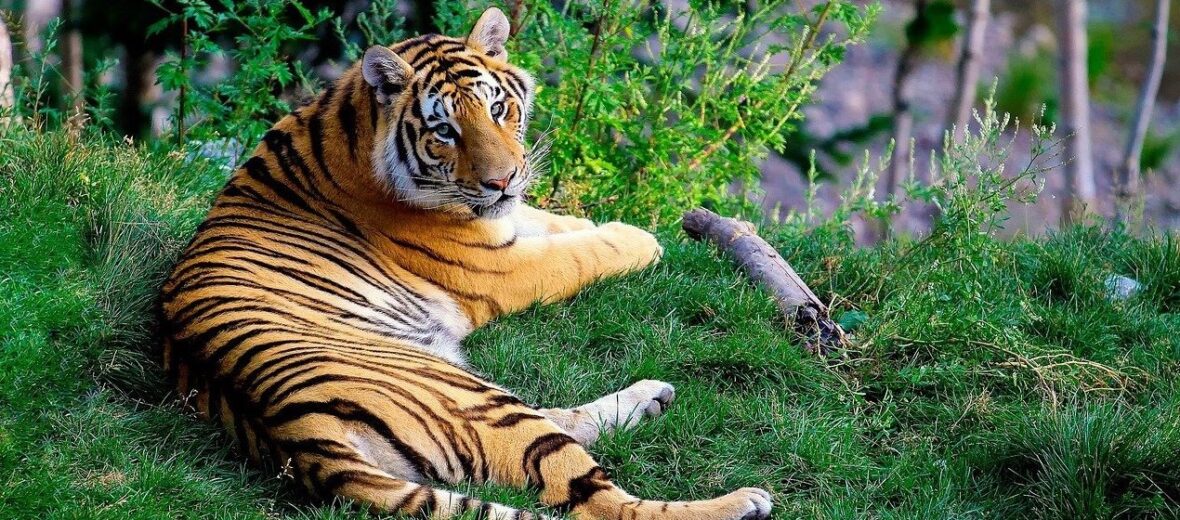
The Bengal tiger, aka Royal Bengal tiger, is native to the Indian subcontinent. Bengals have been around since the Late Pleistocene. Which is about 12,000 to 16,500 years. They prefer tropical dry forests, tropical moist evergreen forests, tropical and subtropical moist deciduous forests, subtropical and temperate upland forests, mangroves, and alluvial (clay, silt, sand, or gravel deposited by water) grasslands. Due to habitat loss, poaching, human interference, and inbreeding (due to a shrinking habitat), these beautiful cats are listed as Critically Endangered, with only around 2,500 remaining in the wild, to date. But their numbers are slowly on the rise.
First the Stats…
Scientific name: Panthera tigris tigris
Weight: Up to 575 lbs.
Length: Up to 10 feet, including tail
Height: Up to 3.6 feet, at the shoulder
Lifespan: Up to 25 years
Now on to the Facts!
1.) Like most cats, Bengals are solitary. Only coming together to mate.
2.) These giant kitties prey on chital, sambar, gaur, barasingha, water buffalo, nilgai, serow, takin, wild boar, hog deer, Indian muntjac, grey langur, porcupines, hares, peafowl, domestic livestock, Asian black bears, sloth bears, and dhole.
3.) The only predators of Bengal tigers are humans.
4.) Even though they technically can, in a pinch, Bengal tigers don’t climb trees. They are terrestrial (spend their lives on the ground).
5.) Like other big cats, Bengal tigers are excellent swimmers and will even chase down prey by swimming after them.
But wait, there’s more on the Bengal tiger!
6.) Their primary attack is by ambush, as these big cats aren’t the fastest out there. Once they subdue a prey animal, they will kill it with a swift bite to the base of the skull, severing the spinal cord.
7.) Felinologists (scientists that study cats) can differentiate each tiger spotted, due to their unique stripes. A tiger’s skin is also striped.
Did you know…?
The canines of a Bengal tiger are among the largest of any land carnivore… up to 3 inches!
8.) Having the largest brain of any land carnivore, sans the polar bear, a tiger’s brain can weigh up to 10.6 ounces!
9.) A tiger’s short term memory is better than that of a human. It’s about 30 times greater than ours, to be exact!
10.) After a kill, a Bengal tiger can consume up to 80 lbs. of meat, in 1 night!
But wait, there’s still more on the Bengal tiger!
11.) A Bengal tiger’s punch is considered the strongest punch of all the feline species. It is strong enough to smash a cow’s mouth. Look out, Mike Tyson.
Did you know…?
The bite force of a Bengal tiger can measure up to 1,050 psi!
12.) A tiger’s saliva is used as an antiseptic and helps to cull infections, should they get injured.
13.) Bengals, like other tiger species, are nocturnal (active at night).
14.) In Champawat (a town in Uttarakhand, India), there was a female tiger who was on record for killing an estimated 436 people, before being killed by a hunter. That pails in comparison to the amount of tigers humans have killed though.
15.) A Bengal can drag its prey up to half a mile. Even if their kill is larger than the tiger.
But wait, there’s still a little more on the Bengal tiger!
16.) Bengals can leap up to 10+ feet in the air!
17.) The roar of a Bengal can be heard up to 1.2 miles away.
18.) A single tiger may patrol an area of up to 60 square miles!
19.) Male tigers mark their territory via spraying urine. And they can get a pretty good distance.
20.) The Warli people, of India, consider the tiger to be a god.
Now a Short Bengal Tiger Video!
Be sure to share & comment below! Also, check out the Critter Science YouTube channel. Videos added frequently!
Want to suggest a critter for me to write about? Let me know here.



